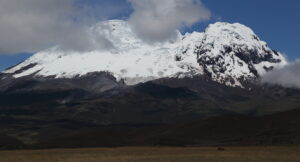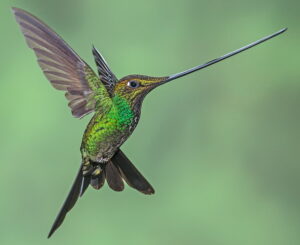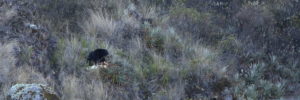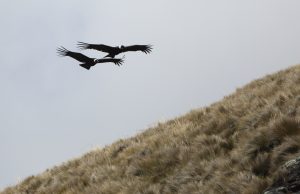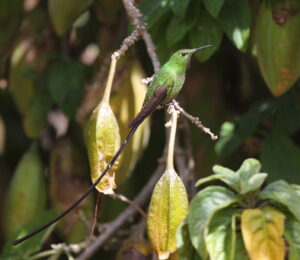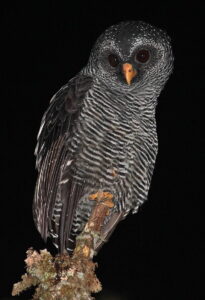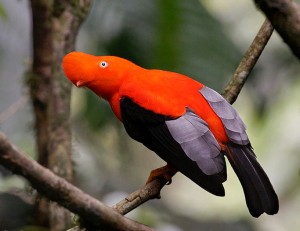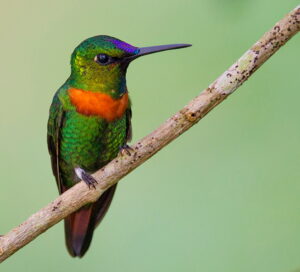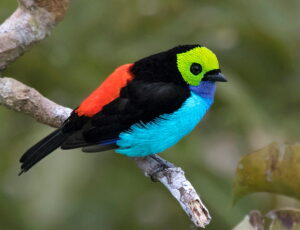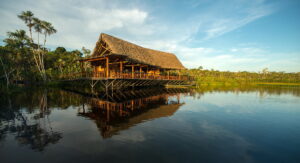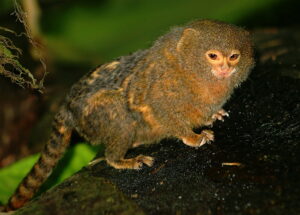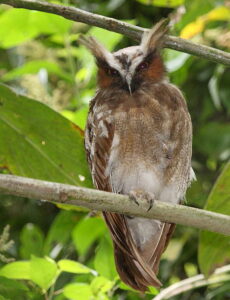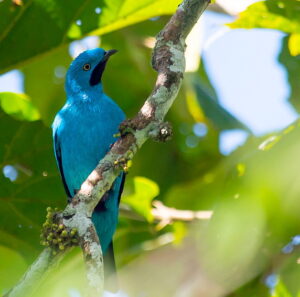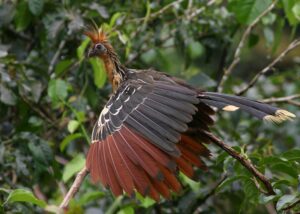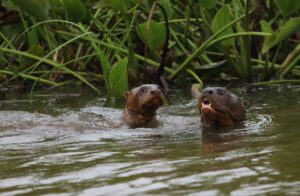As we travel down the eastern slope of the lofty Andes, through a range of exciting habitats, from the treeless montane Paramo, through lush cloud forest and sub-tropical forest into the towering tropical rainforest of the mighty Amazon basin, we shall encounter an amazing wealth of biodiversity. With over 1600 bird species alone, despite its small size, Ecuador has the world’s fourth longest bird list! A glance through the hefty fieldguide shows just how colourful and exotic these tropical birds can be, but don’t take my word for it, come and see for yourself!
During this fantastic journey, moving between top class lodges in idyllic locations, we shall visit the very best places that this special region has to offer, while accompanied by Juan Carlos Calvachi, one of Ecuador’s top bird guides, who knows all the locations, songs and calls. Along the way we can hope to see around a quarter of all the bird species on the Ecuador list! Amazing or what?
Day 1 We depart Heathrow airport on a late evening overnight flight to Quito with Avianca, via Bogota. Dinner and overnight in flight.
Day 2 This morning we land in Quito, meet our local guide and begin the tour by exploring the nearby Papallacta Pass at almost 11000 feet in search of exciting birds like Rufous-bellied Seedsnipe, Blue-mantled and Rainbow-bearded Thornbills, Ecuadorian Hillstar, White-chinned Thistletail, Giant Conebill and Masked Mountain-Tanager. We shall also make a special effort to find a rare Spectacled Bear, which we were lucky enough to see on our previous visit in 2019!
Beyond the pass we drive to the small and homely Guango Lodge in the nearby forested mountains at around 9000 feet, in a beautiful setting amid a large private reserve with a bird list of at least 135 species. This afternoon, we explore the area around the lodge which is a paradise for higher altitude ‘hummers’ including Tourmaline Sunangel and the unique Sword-billed Hummingbird, with an incredible unwieldy looking ‘lance’ for a bill, which is actually longer than its body! This has to be seen to be believed. Along the trails here we may find birds like Andean Guan and Potoo, Grey-breasted Mountain-Toucan, Turquoise Jay, White-capped Dipper, Dusky Piha, Slaty-backed and Rufous-breasted Chat-Tyrants, Grey-hooded Bush-Tanager, Blue-backed Conebill, Slaty Brushfinch, Black-headed, Black-capped and Black-eared Hemispinguses plus Scarlet-bellied, Buff-breasted, Hooded and Lacrimose Mountain-Tanagers and Torrent Duck. The swimming power of this handsome duck is amazing as it bobs effortlessly in raging white water. Dinner and overnight at Guango Lodge.
Day 3 We have a day trip into the stunning scenery of Antisana Volcano National Park, where the snow-clad Antisana Volcano rises to 19000 feet above sea level. Birding from the roadsides between 11000 and 13000 feet, we can hope to see Paramo specialities like Andean Ibis, Teal, Coot, Lapwing and Gull, plus Caranculated Caracara, Silvery Grebe, Black-chested Buzzard-Eagle, Black-winged Ground-Dove, Many-striped and Streak-backed Canasteros, Chestnut-winged and Stout-billed Cinclodeses, Paramo Ground-Tyrant and Plumbeous Sierra-Finch, as well as Ecuador’s national bird, the majestic Andean Condor. While enjoying lunch in a local restaurant we can also enjoy close views of Black Flowerpiercer, Giant Hummingbird, Shining Sunbeam and the amazing Black-tailed Trainbearer, a hummingbird with a tail longer than its body! Dinner and overnight at Guango Lodge.
Day 4 We continue our journey down the eastern slope of the Andes, with birding stops along the way. The lower we go the more diverse the birdlife becomes. Journey’s end today is Cabañas San Isidro, another fabulous lodge with a large private forest reserve in the picturesque Quijos valley at 6700 feet, with a list of 330 birds, as well as Night Monkeys, Black Agoutis and even Mountain Tapirs in the grounds. Arriving at the lodge in time for lunch, we have the afternoon to watch the bird feeders and begin to explore the extensive trails which offer world class birding in some of the most beautiful montane forest anywhere on the eastern slope, with specialities like Highland Tinamou and Motmot, White-bellied and Peruvian Antpittas, Black-billed Mountain-Toucan, Powerful Woodpecker, Inca Jay, Black-chested Fruiteater, Bicoloured Antvireo, Black-billed Peppershrike, White-capped Tanager and the taxonomically mysterious San Isidro Owl! Dinner and overnight at Cabañas San Isidro.
Day 5 We have a full day to explore the trails through a variety of lush montane biomes around the western headwaters of the Amazon basin where possibilities in this productive area include Sickle-winged and Wattled Guans, Rufous-banded Owl, Bronzy Inca, Slate-crowned Antpitta, Masked Trogon, Oleaginous Hemispingus (I am not making this up!), Grass-green Tanager, Rufous-crowned Tody-Flycatcher and many more subtropical species. On top of all this, a short walk from the lodge takes us to a fantastic Andean Cock-of-the-Rock lek, where up to a dozen of these flamboyant males form a raucous social gathering, posturing and squabbling noisily every morning before quietly disappearing into the forest! This should be one of many highlights of the tour. Dinner and overnight at Cabañas San Isidro.
Day 6 We continue our journey down the eastern slope, with birding stops along the way, arriving at our next base in time for lunch at yet another superb lodge, this time called Wild Sumaco, with a wonderful mix of cloud forest, foothill and Amazonian species near Sumaco National Park in a reserve from 3900 to 4900 feet, where over 520 bird species have been recorded, including over thirty hummingbirds! These ‘gems’ include Gould’s Jewelfront, Black-throated and Violet-fronted Brilliants, Gorgeted Woodstar, Ecuadorian Piedtail, Wire-crested Thorntail, Napo Sabrewing, White-tipped Sicklebil, Rufous-vented Whitetip and Violet-headed Hummingbird, many of which can be enjoyed from the lodge’s sixty foot long observation deck. Dinner and overnight at Wild Sumaco.
Day 7 We have a full day to explore the Wild Sumaco trails on the lookout for a long list of possible birds like Buckley’s Forest-Falcon, Dusky-billed Parakeet, Chestnut-fronted and Military Macaws, Golden-collared Toucanet, Band-bellied Owl, Fiery-throated and Scarlet-breasted Fruiteaters, Plain-backed Antpitta, Grey-tailed Piha, Coppery-chested Jacamar, Black-streaked Puffbird, Short-tailed Antthrush, Foothill Antwren, Chestnut-crowned Gnateater, Large-headed Flatbill, Yellow-throated Spadebill, Red-billed and Ecuadorian Tyrannulets and Blue-browed, Orange-eared and stunning Paradise Tanagers. Dinner and overnight at Wild Sumaco.
Day 8 We leave the Andean foothills and descend into the Amazon basin. From the town of Coca, a two hour boat ride takes us down the Napo river, and deep into Amazonia, to the world famous Sacha Lodge, which offers a true jungle adventure as well as a teeming bird list of almost 600 species, representing around 37% of all Ecuador’s birds and 7% of the world’s birds! This fantastic lodge in a 5000 acre private reserve amid pristine rainforest on the shore of Lake Pilchicocha also allows sightings of Giant River Otters and Caimans from the open sided restaurant. There are also eight species of monkey here including hefty 17 pound Red Howlers and the ‘pocket sized’ Pygmy Marmoset, which is the world’s smallest monkey at just 3.5 ounces! Dinner and overnight at Sacha Lodge.
Days 9 – 11 We have the luxury of three full days to experience the diverse wildlife of this remarkable place, where opportunities include panoramic views of the forest from a 135 foot high tower built on the top branches of a giant Kapok tree, plus unrivalled views above the treetops from a 120 foot high, 1200 foot long canopy walkway and intimate wildlife viewing from tranquil canoe rides through the extensive waterways. Another undoubted highlight will be a visit to one of Ecuador’s best ‘clay licks’, where hundreds of noisy parrots visit a river cliff in nearby Yasuni National Park to ingest minerals to aid their digestion. Species commonly seen here include White-eyed and Dusky-headed Parakeets, Yellow-crowned Amazons and Mealy and Blue-headed Parrots. As well as over eleven different Manakins, fifty odd Antbirds and seventy plus Flycatchers we can hope for dazzling sightings like Agami and Boat-billed Herons, Slender-billed, Hook-billed and Double-toothed Kites, Crested Owl, Tawny-bellied and Tropical Screech-Owls, Common and Great Potoos, Cream-coloured and Chestnut Woodpeckers, Lemon-throated and Gilded Barbets, Long-billed Woodcreeper, Spangled and Plum-throated Cotingas, plus Green-and-gold, Masked, Opal-crowned, Opal-rumped and Masked Crimson Tanagers, as well as the bizarre Hoatzin. Dinners and overnights at Sacha Lodge.
Day 12 We take the boat trip back to Coca where we transfer to the airport for a domestic flight back to Quito for a night at the lovely Casa de Campo Tababela, an opulent ‘family home’ in beautiful green gardens not far from the airport. Dinner and overnight at Casa de Campo Tababela.
Day 13 We have a leisurely day to enjoy the comfort of ‘our casa’ before leaving for the airport to check in for an evening flight home, via Bogota, with Avianca. Dinner and overnight in flight.
Day 14 At the end of an absolutely fabulous journey, packed with so many highlights and memories, we arrive back in Heathrow this afternoon.
Cost; £4990
Single supplement; £800
Deposit; £1200
What the price includes:
Return flights from London Heathrow to Quito, via Bogota, with Avianca, eleven nights’ full board en-suite accommodation, water, all road and river transport, all lodge-based activities and reserve entry fees, bird checklist, the services of your guides, domestic flight from Coca to Quito and airport transfers in Quito, but not drinks with meals or tips.
Additional information:
The flight time to Bogota is 11 hours and the onward flight to Quito is 1 hour 40 minutes. The return flight to Bogota is 1 hour 35 minutes and the onward flight to Heathrow takes 10 hours 35 minutes.
A visa is not required for British citizens to visit Ecuador.
It is advisable to be vaccinated against Hepatitis A, Yellow Fever and Typhoid. There is little or no risk of Malaria.
In Ecuador, the climate varies widely according to the altitude. In Quito in December, temperatures range from 8 – 22°C, and so the average is 15°C. In December, there is a 50% chance of rain each day, with a monthly total of 3.3 inches, which is almost twice the amount we get at home in the same month. On the eastern slope in December, temperatures range from 17 – 27°C, and so the average is 22°C. In December, there is rain most days, with a monthly total of 12 inches, which is about six times the amount we get at home in the same month. In the Amazon region in December, temperatures are stable at around 25°C. In December, there is a 70% chance of rain each day, with a monthly total of 9.6 inches, which is almost five times the amount we get at home in the same month.
Outside Quito we shall be staying in four comfortable and charming lodges, in superb wildlife rich locations, with little time spent travelling on most days.
This tour involves easy walks with excellent photo-opportunities and we can expect to see around 400 bird species in addition to several special mammals and reptiles.

